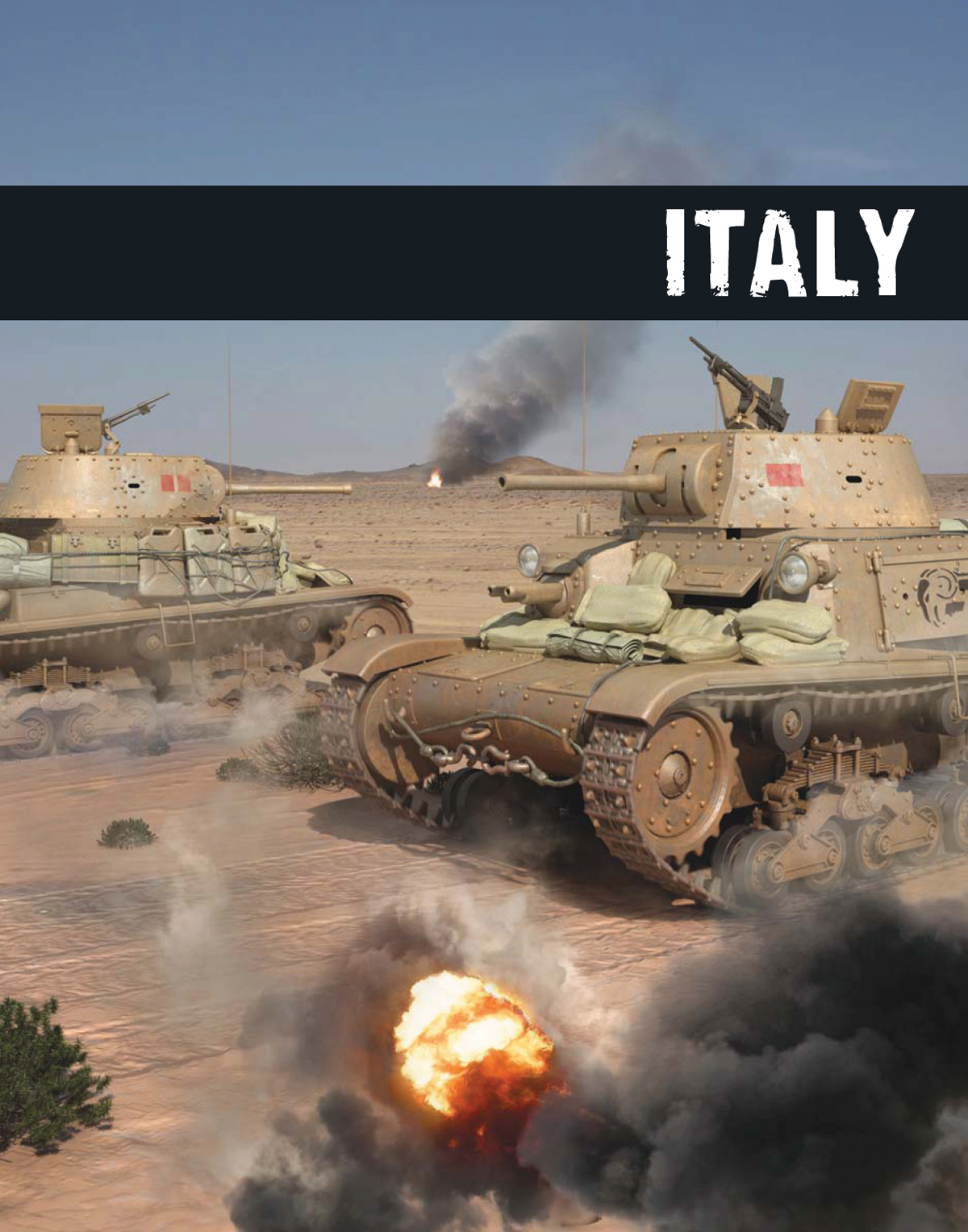

M 13/40 of the Ariete Armoured Division, Western Desert, August 1942, by Richard Chasemore © Osprey Publishing Ltd. Taken from New Vanguard 195: Italian Medium Tanks.
Italy’s fascist dictator, Benito Mussolini, tried to capitalize on his close relationship with Germany by launching his own attacks on neighbouring lands. Despite copious propaganda to the contrary, the Regio Esercito or Royal Italian Army was ill prepared for offensive operations – a fact quickly made evident. Italy’s first offensive action occurred in June 1940, when 32 divisions made a two-pronged attack on France, advancing along the Mediterranean coast and into the French Alps. Despite the French already being beaten to the north, resistance was unexpectedly stiff, inflicting far more casualties on the Italians than those suffered in return. Still, as Mussolini said to his army chief of staff, ‘I only need a few thousand dead so that I can sit at the peace conference as a man who has fought’.
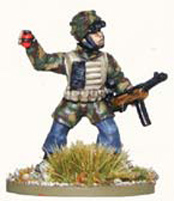
Italian propaganda boasted eight million bayonets were standing at the ready, prepared to fight wherever need be. In reality, the number was far smaller. A total of 4 million Italians served in the armed forces over the course of the entire war. This figure includes the years after 1943, when the majority of Italian fighters joined the Allied effort after the fall of Rome. Regardless of the claims of Mussolini’s propaganda machine, Italy’s only successful campaign, launched on her own, was against British-held Somaliland. Invasions in Greece and colonial North Africa were unsuccessful until German allies could join stalled Italian attacks and turn the tide. Lacking true armoured might, Italy’s gains during World War II were made on the backs of her infantry divisions.
The Italian infantry division was unique for the era, making use of a ‘binary’ structure. Two regiments made up a division, rather than the usual ‘triangle’ or ‘square’ shape utilizing three or four divisions respectively. Several infantry divisions also had two battalions of Blackshirts attached to provide a political, fascist element to the regular army. Infantry divisions were well supported by artillery, although most of was World War I vintage. Barring a few exemplary veteran divisions, much of the Italian army was untested and poorly equipped to fight a modern war.
Learning from their early experiences in North Africa, much of the Italian forces underwent a complete re-organization. This ‘AS42’ organization embraced the concept of ‘few men, many weapons’ and re-organized several infantry divisions into lean combat units. The core company was integrated into a battle group with a higher proportion of machine and antitank guns. In theory, these AS42 infantry divisions were to be highly mechanized, though in practice that was rarely the case. These restructured units did, however, prove to strengthen Italian defensive positions.
The army list and theatre selectors described in this book include units that fought in the Regio Esercito up to the armistice of early September 1943 that marked the surrender of the Italian armed forces to the Allies. After that, Italian soldiery broke up into many different factions. Some would enroll with the Allies and were re-equipped with American gear; some would continue to fight alongside their German former comrades in the Repubblica Sociale, a Nazi-controlled puppet state in northern Italy; some would join the many partisan bands that roamed the countryside and the mountains of the Italian peninsula during the bitter civil war that followed Italy’s capitulation; while some would just attempt to lose themselves amongst the civilian population, and probably end as slave labour in German prison camps.
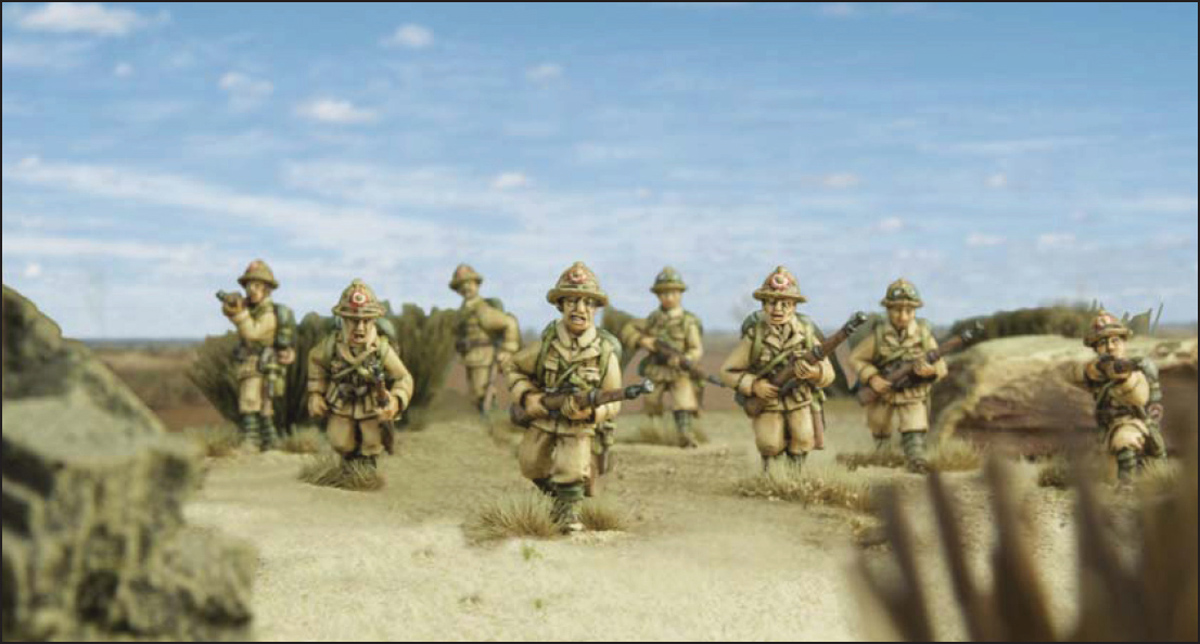
Italian troops close with the enemy
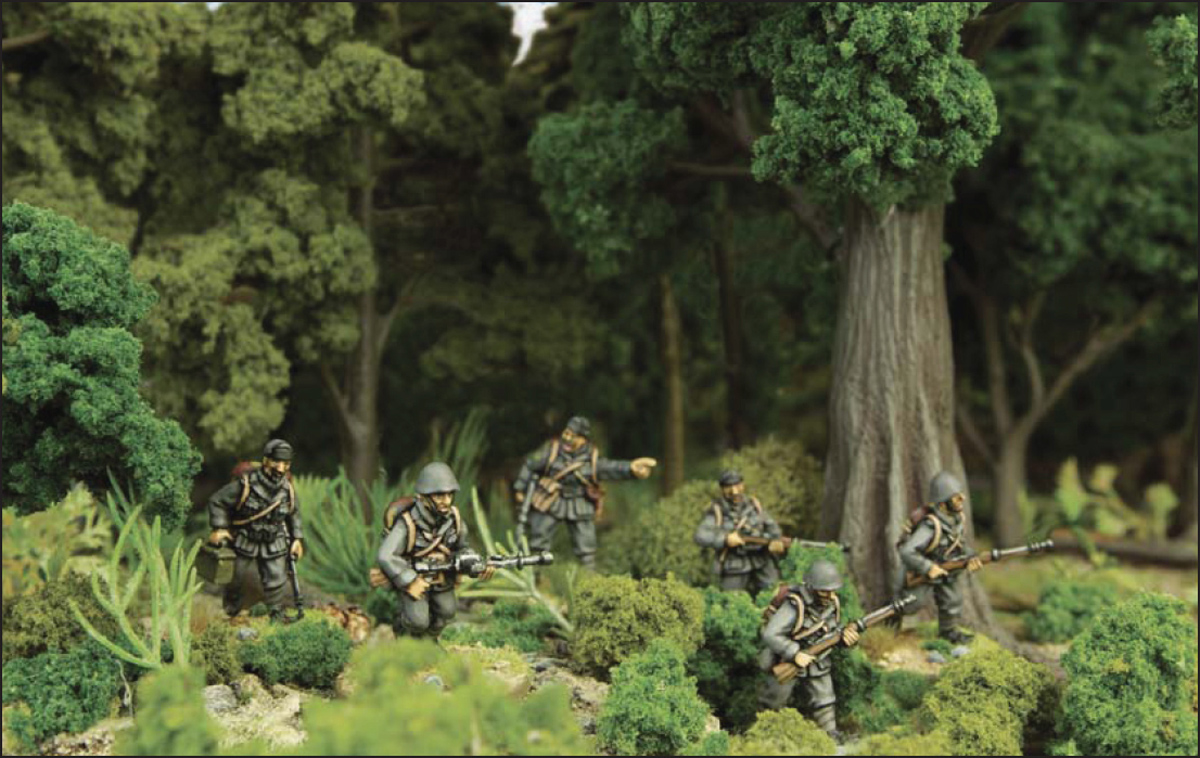
Italian troops scurry through the forests of Russia
Italians in Bolt Action present some interesting ideas. Their vehicles, while outmatched by many of their opponents, are quite capable at taking on infantry and light guns. Their infantry provide lots of flexibility and modelling opportunities, as well as interesting challenges during game play. From the elite Motociclisti or motorcycle troops to the untested and inexperienced infantry sections, we think the Italians will be great fun to field on the table!
One of the most spectacular and daring stories to come out of World War II was the Gran Sasso raid, or Operation Oak. In 1943, when the Allies landed in Sicily, the Italian government voted to oust Mussolini, and shortly thereafter he was arrested on orders of the king. Otto Skorzeny, a German special operations soldier famed for his use of American disguises during the Battle of the Bulge, intercepted a radio message, and determined that Mussolini was being held at Campo Imperatore, an Alpine ski resort. Shortly thereafter, a high-risk aerial assault rescue mission was hatched, and nine gliders loaded with troops from the 2nd Fallschirmjäger Division took off.
The raiders crash-landed their gliders and overwhelmed the hotel without a shot being fired. When Skorzeny greeted Il Duce with the words ‘The Führer has sent me to set you free’, Mussolini responded, ‘I knew that my friend would not forsake me!’ Skorzeny then flew both of them in a tiny Storch (which was barely flyable thanks to Il Duce’s added weight) to safety, where Mussolini was given a hero’s welcome.
Although the raid went off without a hitch, this could make for an exciting Bolt Action ‘what if’ scenario. A fairly simple modification of ‘Top Secret’ featuring an elite Fallschirmjäger platoon against some regular and inexperienced Italians could be great fun!
This is the official Bolt Action Army List for the forces of the kingdom of Italy. Players can pick an army in either of two ways.
• Use the Reinforced Platoon selector from the Bolt Action rulebook in conjunction with the Army List in this book. To save referencing the rulebook, the generic Reinforced Platoon selector is repeated below.
• Instead of using the generic Reinforced Platoon selector, use any one of the theatre selectors on page 29-35 in conjunction with the Army List given in this book.
Either method is perfectly acceptable depending on what kind of game you wish to play. The first method uses the generic selector and is more flexible and therefore ideal for pick-up games against any opponent, as it allows for a wider variety of different kinds of troops and equipment. The second method, using the theatre selectors, is more historically representative and therefore better suited for games where a historical portrayal is envisaged. We imagine that players will, on the whole, prefer to fight battles within a specific historical context, in which case simply use the appropriate theatre selector to choose your army.
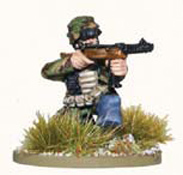
1 Lieutenant – First or Second
2 Infantry squads
plus:
0–3 Infantry squads
0–1 Captain or Major
0–1 Medic
0–1 Forward Observer (either Artillery or Air)
0–1 Machine gun team
0–1 Mortar team
0–1 Sniper team
0–1 Anti-tank team
0–1 Field Artillery, Anti-aircraft or Anti-tank gun
0–1 Armoured Car
0–1 Tank or Tank Destroyer
0–1 Transport vehicles or tow (soft-skins or armoured) per infantry and artillery unit in the Reinforced Platoon
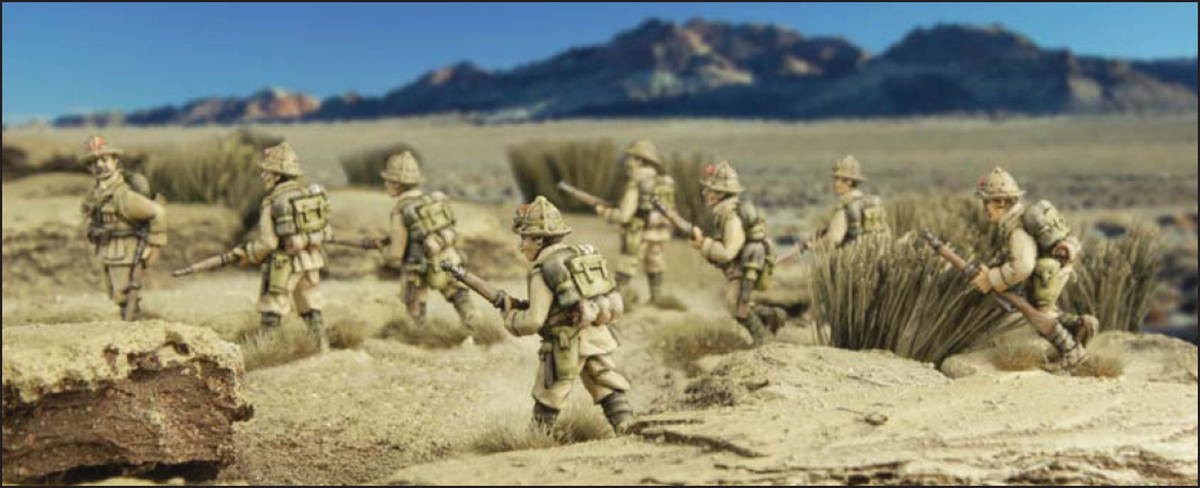
‘Avanti Savoia!’ Italian troops charge the enemy.
The Italian infantry division was unique in Europe for its ‘binary’ formation (that is, the core of the division was comprised of two regiments rather than the more standard three). However, the unique challenges faced by the Italian forces in North Africa (Africa settentrionale) led to a re-organization in 1942. These new divisions (referred to as A.S.42 divisions) were comprised of two infantry regiments, an artillery regiment, an engineer battalion, and other support sections.
They differed from standard infantry divisions at the company level, whereby the companies were greatly expanded and included high concentrations of firepower. Several machine guns and antitank guns were integrated into each platoon, operating largely on the ‘few men, many weapons’ doctrine. On paper these divisions were to be entirely mechanized. In practice, of course, they never came anywhere near that capability, and suffered like the rest of the Italian army from generally poor mobility.
The morale of Italian troops was often subject to very radical and very quick changes, both for good and for ill.
At the beginning of each game turn, subtract the number of units lost by the Italian army from the number of units lost by the enemy (keep track of the Order die lost by both sides). If the number is -3 or worse (i.e. the Italians are losing three units more than the opposition), all friendly Italian units have their basic Morale reduced by 2. If the number is +3 or better (i.e. the battle is going really well for the Italians), all friendly Italian units have their basic Morale increased by 2.
Italian strategic thinking and the very organization of its army was geared to a fairly static and defensive approach to warfare.
In scenarios with an attacker and a defender, first roll as normal to determine which side is going to be the defender. If the Italian player is not the defender, you must re-roll that dice – the second result stands. Note that in an Italian versus Italian battle neither player gets to re-roll.
If the Italian army is the defender (including against Italian attackers), it gets the following advantages:
• During the first turn of the game, the enemy cannot order his units to Run as they cautiously probe the terrain in front of the Italian line for minefields and make their way across the barbed wire.
• The player can re-roll the die on the Artillery Barrage and Smoke Barrage chart – the Italian artillery is already ranged in on no-man’s land.
• During set-up, any Italian unit starting the game Hidden (as described on p.117 of the Bolt Action rulebook) may start the game already in Ambush. If you decide to do so, place one of your Order Dice already in place next to them, as if you had ordered them to Ambush.
• After determining table edges, but before either side deploys any unit, roll a D3 – the result is the number of emplacements available to the player. Each emplacement is made of three linear obstacles up to 6in. long and 1in. tall, representing hard cover like sandbags, a section of low wall or earthwork, which are always placed as shown in the picture below. These are placed by the player so that they are all completely within 12in. of his table edge.
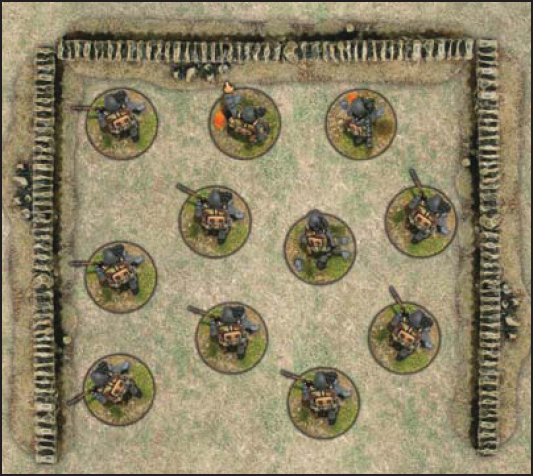
The list is divided into categories as follows:
| 1 Infantry | Headquarters units Infantry sections and teams |
| 2 Artillery | Field artillery Anti-tank guns Anti-aircraft guns |
| 3 Vehicles | Tanks Self-propelled guns Anti-aircraft vehicles Armoured cars and recce vehicles Transports and tows |

Italian troops in Greece, 1940–41 (L–R): Caporale, 31st Inf Regt, ‘Siena’ Inf Div; Soldato, 77th Inf Regt, ‘Lupi di Toscana’ Inf Div; Camicia nera (Blackshirt), 1st Albanian Legion MVSN, by Stephen Andrew © Osprey Publishing Ltd. Taken from Men-at-Arms 340: The Italian Army 1940–45 (1).
Italian platoons are organized much like those of other nations, centring upon a command element and two or more squads. Italian officers were a mixed bag, with some enthusiastically serving in the Royal Italian Army, and others reluctant to fight for seemingly worthless territories far from home. Still, the responsibility of accomplishing their mission and looking after their men fell on these officers’ shoulders, with most rising to the challenge.
Platoons were typically commanded by a first or second Tenente (Lieutenant). Lieutenants in the Royal Italian Army were committed to restoring Italy to international prominence, despite being unprepared for the realities of a modern war. An officer unit consists of the officer himself and can include up to two other men acting as his immediate attendants. Officers can be rated as Inexperienced, Regular, or Veteran.
Cost: Second Lieutenant 35pts (Inexperienced), 50pts (Regular), 65pts (Veteran)
First Lieutenant 60pts (Inexperienced), 75pts (Regular), 90pts (Veteran)
Captain 95pts (Inexperienced), 110pts (Regular), 125pts (Veteran)
Major 135pts (Inexperienced), 150pts (Regular), 165pts (Veteran)
Team: 1 officer and up to 2 further men
Weapons: Pistol, sub-machine gun, or rifle as depicted on the models
Options:
• The officer may be accompanied by up to 2 men at a cost of +7pts per man (Inexperienced), +10pts per man (Regular), or +13pts per man (Veteran)
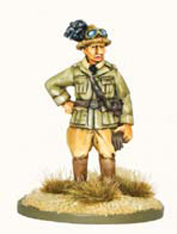
Soldiers trained to assist their wounded comrades served in every modern army during World War II, and the frontline medical professionals of the Regio Esercito were no different. Although medics were not officially armed combatants, the circumstances of battle sometimes called for medics to arm themselves, thereby excluding them from the limited protection offered under various articles of the Geneva Conventions.
Cost: 30pts (Veteran)
Team: 1 medic and up to 2 further men
Weapons: Pistol or none as depicted on the model
Options:
• The medic may be accompanied by up to 2 men at a cost of +13pts per man (Veteran)
Whether it is an artillery battery miles away from the battlefield, a naval gunship out to sea, or a ground attack aircraft high above the fighting, such weapons systems would be much less effective without the services of well trained forward observers. Each infantry division was assigned its own artillery support assets in the Regio Esercito, and although many of the artillery pieces and aircraft were outdated, they were nonetheless quite lethal under the right circumstances. Given the firepower these forward observers could bring to bear on their targets, their neutralization was a high priority to opposing commanders.
Cost: Artillery Forward Observer 100pts (Regular), 115pts (Veteran)
Air Force Forward Observer 75pts (Regular), 90pts (Veteran)
Team: 1 Forward Observer and up to 2 further men
Weapons: Pistol, sub-machine gun, or rifle as depicted on the models
Options:
• The observer may be accompanied by up to 2 men at a cost of +10pts per man (Regular) or +13pts per man (Veteran)
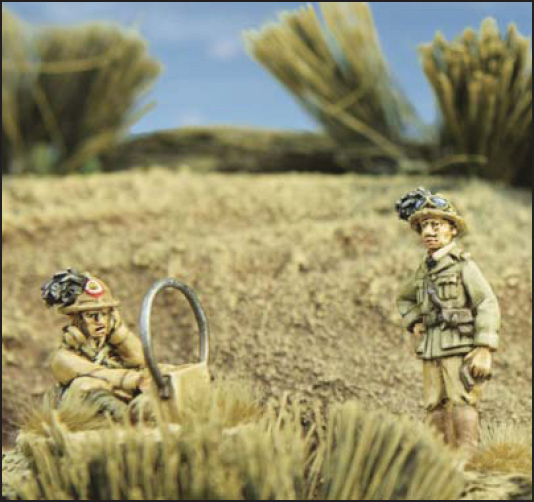
New orders come in from HQ
Mussolini famously boasted that the Italian army had eight million bayonets standing at the ready. In actuality, the standing Italian army was far smaller than that, with huge numbers of troops conscripted into a war they neither believed in nor understood. The fighting ability of units of the Italian army varied greatly, with much of the rank and file lacking proper equipment, transport and even motivation. Still, there were several key battles in North Africa and the Eastern Front where they performed well. The standard rifle was the Carcano Model 1891 as used in World War I. With a relatively small calibre of 6.5mm, this weapon had less stopping power than British or German rifles, and for this reason some weapons were re-chambered to take 7.35mm ammunition, adding somewhat to the problems of munitions supply. The excellent 9mm Beretta M38 was the standard sub-machine gun. The Italian light machine gun – the Breda Model 1930 – suffered from slow rate of fire, the same small calibre ammunition as the squad’s rifles, and a mechanism prone to jamming and breakage. Hand grenades were also less effective than those used by the Germans and British – these small explosive grenades were painted red and called ‘red devils’ by the British. An incendiary type of anti-tank grenade was developed – the OTO model 1942 – as well as the explosive Type L with a charge of TNT. Before these became available, improvised anti-tank grenades were made by means of attaching a larger explosive charge to a regular grenade – these were called Passaglia bombs.
Cost: Regular infantry 50pts
Composition: 1 NCO and 4 men
Weapons: Rifles
Options:
• Add up to 6 additional soldiers at +10pts each
• The NCO may have a sub-machine gun for +3pts
• One soldier may have a light machine gun for +20pts – another soldier becomes the loader
• The entire section can be given anti-tank grenades for +2pts per man
Special Rules:
• Tank Hunters (if anti-tank grenades taken)
Unfortunately, much of the Italian army was comprised of poorly trained and equipped infantry that were not quite as keen as Mussolini to reclaim the Roman Empire. Inexperienced troops would be more likely to be equipped with older or obsolete weapons, such as the Mannlicher rifle or even the antique Vetterli-Vitali used for training.
Cost: Inexperienced infantry 35pts
Composition: 1 NCO and 4 men
Weapons: Rifles
Options:
• Add up to 6 additional soldiers at +7pts each
• The NCO may have a sub-machine gun for +3 pts
• One soldier may have a light machine gun for +20 pts – another soldier becomes the loader
• Inexperienced infantry can be Green at no extra points cost
• Inexperienced infantry can be Shirkers for a reduction of 3pts per man
Special Rules:
• Green or Shirkers if either option is chosen
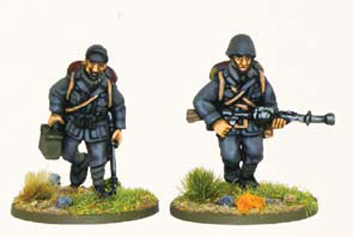
Italian Army light machine gun team

Italian Army section
The MVSN or Milizia Volontaria per la Sicurezza Nazionale (Voluntary Militia for National Security) was made by the Fascist Party into a paramilitary organization similar in concept to the German SS. The rank and organizational terminology used by the MVSN was very close to that of ancient Rome, with legions, centuries, cohorts, maniples and so on. Mostly concerned with territorial security and counter-partisan activities, in wartime the Camicie Nere were organized into ‘assault legions’ that were fielded alongside regular army infantry divisions to reinforce them and as a way to ‘politicize’ the Regio Esercito. The quality of these militia units varied immensely, ranging from barely trained village bullies to veterans of the Spanish Civil War and highly motivated ‘Giovani Fascisti’ (young fascists) – in gaming terms, we have chosen to rate them on average as Regular infantry but with a varied morale, as represented by the Non Testati special rule.
Cost: Regular infantry 50pts
Composition: 1 NCO and 4 men
Weapons: Rifles
Options:
• Add up to 6 additional soldiers at +10pts each
• The NCO may have a sub-machine gun for +3pts
• One soldier may have a light machine gun for +20pts – another soldier becomes the loader
• The entire section can be given anti-tank grenades for +2pts per man
Special Rules:
• Tank Hunters (if anti-tank grenades taken)
• Non Testati: The ‘Legionaries’ were often non testati (untested) and often only summarily trained, but some elements had a very strong ideological motivation and some combat experience. While this often meant a unit quickly lost its nerve before a foe, it frequently meant the unit fought on stubbornly. To represent this, immediately before the opponent rolls to hit in shooting or for casualties in close combat versus a Camicie Nere section, its controller rolls a D6. On a result of 1-2, the section loses its will to fight and gains Shirkers. On a 3-4, the section remains the same. On a 5-6, the section is filled with patriotic bravery and gains Fanatics. Apply the ability before resolving the shooting or close combat
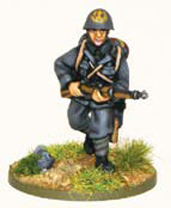
The Bersaglieri were an elite, mobile infantry force in the Regio Esercito known for the black feathers adorning their combat helmets. Every soldier in the ranks of the Bersaglieri endured intense training and was required to be a qualified marksman. Rommel once remarked, ‘The German soldier impressed the world; the Bersaglieri impressed the German soldier.’ Operating on the ‘few men, many weapons’ ideology, the Bersaglieri received some of the best equipment available in the army.
Cost: Veteran infantry 65pts
Composition: 1 NCO and 4 men
Weapons: Rifles
Options:
• Add up to 6 additional soldiers at +13pts each
• The NCO may have a sub-machine gun for +3pts
• Up to two men can have a light machine gun for +20pts each – another man becomes a loader for each machine gun purchased
• The entire section can be given anti-tank grenades for +2pts per man
• The entire section may be mounted on motorcycles for +5pts per model
Special Rules:
• Tank Hunters (if anti-tank grenades taken)
• Motorbikes: a mounted section uses the motorbikes rules (see rulebook)
The Alpini mountain infantry were drawn mostly from the regions neighbouring the Alps and were well trained in field craft and in combat and survival techniques in broken terrain and wintery conditions. This training and skills made them an excellent choice for operations in the Balkans and on the Eastern Front.
Cost: Veteran infantry 65pts
Composition: 1 NCO and 4 men
Weapons: Rifles
Options:
• Add up to 6 additional soldiers at +13pts each
• The NCO may have a sub-machine gun for +3pts
• One man can have a light machine gun for +20pts – another man becomes the loader
• The entire section can be given anti-tank grenades for +2pts per man
• The entire section may have skis for +1pt per model
Special Rules:
• Tank Hunters (if anti-tank grenades taken)
• Skis (if option is taken): ski troops ignore movement penalties for snow and other winter conditions

Italian troops at El Alamein, 1942 (L–R): Sottotenente, 21st Mot Arty Regt, ‘Trieste’ Mot Div; Sergente maggiore, 7th Bersaglieri Regt, ‘Trento’ Mot Div; Sergente, ‘Folgore’ Parachute Div, by Stephen Andrew © Osprey Publishing Ltd. Taken from Men-at-Arms 349: The Italian Army 1940–45 (2).
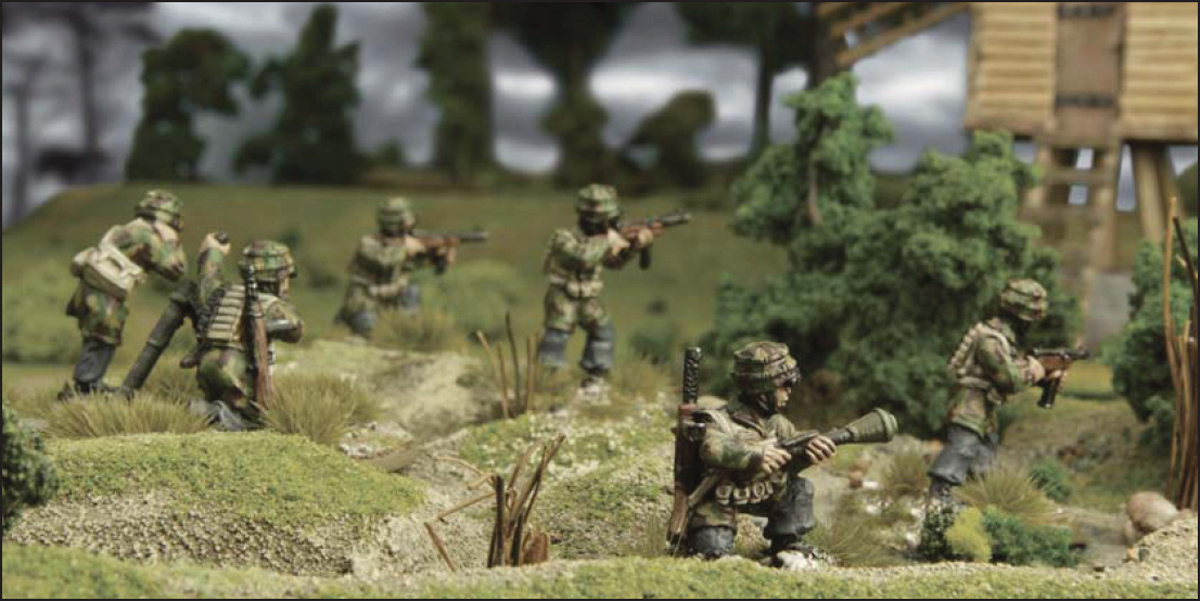
Avanti! Paratroopers of the Nembo division strike
During the climactic battle of El Alamein, the 185 Airborne Division Folgore fought with determination. These brave fighters drove back attack after attack, repelling the British for weeks, before finally being forced to retreat after an Allied breakthrough was achieved elsewhere. It is said that the Folgore fought until expending their last round of ammunition and they managed to take out many British tanks with near-suicidal close quarters attacks. Paratroopers were well equipped with modern gear such as the Beretta Model 38 submachine gun and the Breda machine gun.
Cost: Veteran infantry 70pts
Composition: 1 NCO and 4 men
Weapons: Rifles
Options:
• Add up to 4 additional soldiers at +14pts each
• The NCO can have a pistol instead of rifle for -3pts, or the NCO can have a sub-machine gun instead of rifle for +3pts
• Up to 7 men can have sub-machine guns instead of rifles for +3pts each
• One man can have a light machine gun for +20pts – another man becomes the loader
• The entire section can be given anti-tank grenades for +2pts per man
Special Rules:
• Tank Hunter (if anti-tank grenades taken)
• Stubborn. Paratroops don’t give in easily! If forced to check their Morale when reduced to half strength, then they always test on their full Morale value, ignoring any pin markers
• Skis (if option is taken): ski troops ignore movement penalties for snow and other winter conditions
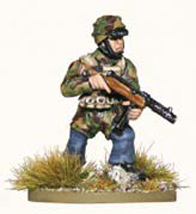
During the second battle of El-Alamein (late October to early November 1942), the Folgore parachute division was deployed in the southern sector of the Axis defensive line. The paratroopers suffered from a severe lack of anti-tank weaponry, having to rely on obsolete 47/32 Elefantinos and improvised anti-tank grenades to stop the British tanks. Their dug-in positions were attacked by the British 7th Armoured Division, the 44th and 50th infantry divisions, and the Free French and Greek brigades. After holding their ground for the whole two weeks of battle, the Folgore finally started to withdraw, and three days later surrendered, out of water and ammunition – they had suffered around 30 per cent casualties and inflicted severe losses on the attackers, destroying around 100 tanks, mostly at close quarters. When they finally surrendered, the British officers allowed them to do so without having to raise their hands or carry a white flag.
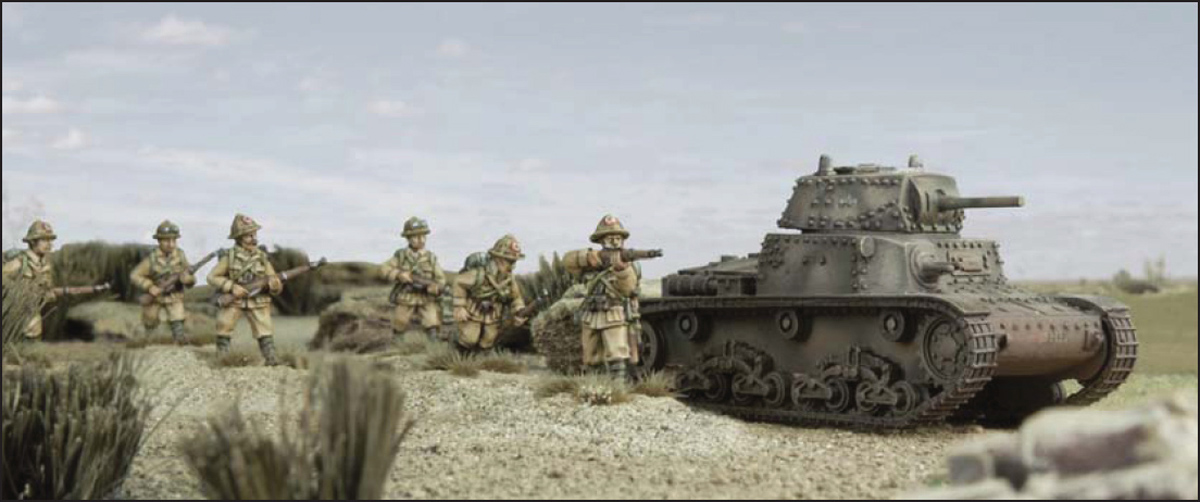
On Mussolini’a orders, Italian forces sweep into Eritrea
The San Marco regiment was a unit of the Italian Navy that grouped several battalions of marines and other minor units that specialized in supporting amphibious assaults (artillery, engineers, and even a platoon of paratroopers/swimmers). The marines of the San Marco underwent a very hard selection and training process, which made them some of the best soldiers in the Italian armed forces. They saw action all around the Mediterranean, but especially in North Africa, where they distinguished themselves in the defence of Tobruk.
Cost: Veteran infantry 70pts
Composition: 1 NCO and 4 men
Weapons: Rifles
Options:
• Add up to 4 additional soldiers at +14pts each
• The NCO can have a pistol instead of rifle for -3pts, or the NCO can have a sub-machine gun instead of rifle for +3pts
• One man can have a light machine gun for +20pts – another man becomes the loader
• The entire section can be given anti-tank grenades for +2pts per man
Special Rules:
• Tank Hunters (if anti-tank grenades taken)
• Behind enemy lines. When Outflanking as described on p.119 of the Bolt Action rulebook, units of San Marco marines ignore the –1 modifier to the Order test for coming onto the table
After the harsh lessons learnt in World War I, there were not many units of cavalry left in the Regio Esercito, but the few that remained, like the Savoia Cavalleria regiment, were highly trained and motivated troops. Deployed on the Eastern Front, the 700 horsemen of the Savoia Cavalleria successfully counterattacked at Isbuschenskij against three advancing battalions of the 812th Siberian Infantry Regiment, in what was to be the very last cavalry sabre charge of the Italian army in a field battle.
Cost: Veteran infantry 75pts
Composition: 1 NCO and 4 men mounted on horses
Weapons: Cavalry carbines
Options:
• Add up to 5 men at +15pts each
• One soldier may have a light machine gun for +20pts – another soldier becomes the loader
Special Rules:
• Cavalry carbines: these short-barrelled rifles count as pistols when used on horseback and rifles when used on foot
The Regio Corpo Truppe Coloniali (Royal Colonial Troops Corps) included different types of trained militia and security forces drawn from the local population of the Italian colonies of Libya (Meharisti, Savari, Spahis), Somalia (Dubats, Zaptiè), Eritrea (Ascari) and Ethiopia (Bande Amhara). Armed with rifles and often with ancestral weapons that made them fearsome close-quarter fighters, these squads were often led by Italian NCOs and in many cases operated as light cavalry in recon roles.
Cost: Inexperienced infantry 40pts
Composition: 1 NCO and 4 men
Weapons: Rifles
Options:
• Add up to 6 additional soldiers at +8pts each
• One soldier may have a light machine gun for +20pts – another soldier becomes the loader
• The entire squad may be mounted upon horses for +2pts per man
Special Rules:
• Tough Fighters
• Cavalry, if option is chosen
Italians used a variety of weapons from various manufacturers, but all tended towards over-complex designs and unreliability. The most successful and most commonly used machine gun was the Breda M37 8mm air-cooled weapon, captured examples of which were used by the British SAS.
Cost: 35pts (Inexperienced), 50pts (Regular), 65pts (Veteran)
Team: 3 men – firer and two loaders
Weapon: 1 MMG
Special Rules:
• Team weapon
• Fixed
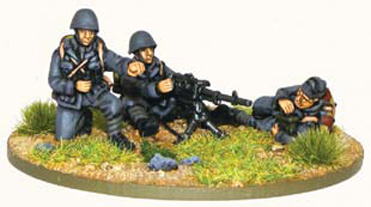
Italian Army medium machine gun team
The Italian army had no specialist sniper rifle, and the relatively light-weight Carcano Model 1891 with its small calibre bullet was not ideally suited to the role. Indeed, the Finnish army, which was supplied with a number of the weapons, relegated them to second line formations for just this reason. However, in the hands of a skilled marksman and fitted with a telescopic sight the weapon would prove deadly enough.
Cost: 50pts (Regular), 65pts (Veteran)
Team: 2 men
Weapons: Rifle
Special Rules:
• Team weapon
• Sniper
The Solothurn anti-tank rifle was a cross between a true antitank rifle and a light anti-tank gun. Featuring a light wheeled carriage and a magazine-feed, the Solothurn could achieve a rate of fire of up to 20 rounds per minute. Although the Solothurn, like most anti-tank rifles of its day, was out of date at the onset of the war, it could still be used effectively to keep pesky, light mechanized patrols at bay, or score a lucky shot on an approaching tank now and again.
Cost: 21pts (Inexperienced), 30pts (Regular), 39pts (Veteran)
Team: 2 men
Weapon: 1 anti-tank rifle
Special Rules:
• Team weapon
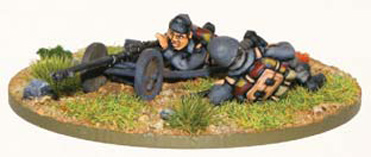
Italian Army Solothurn anti-tank rifle
On paper, every Italian infantry division was to have eight assigned flamethrower teams for digging out entrenched infantry and assaulting fortifications. In practice, of course, these supplies were much more scant. Still, the Guastatori or ‘assault engineers’ were trained in the use of these devices, as well as bangalore tubes, mines, and other engineering tools.
Cost: 50pts (Regular), 65pts (Veteran)
Team: 2 men
Weapon: 1 flamethrower
Special Rules:
• Flamethrower
• Team weapon
Designed in 1935, the Brixia 45mm mortar was relatively difficult to produce in great numbers, given the complexity and cost of manufacturing the weapon. However, the 45mm light mortar was a powerful and successful weapon in the hands of properly trained soldiers. Its rate of fire was higher than similar weapons employed by other nations, and its accuracy was also unparalleled. Unfortunately, the ammunition it used was often poorly designed or manufactured, which hamstrung the best efforts of even a highly competent crew.
Cost: 24pts (Inexperienced), 35pts (Regular), 46pts (Veteran)
Team: 2 men
Weapon: 1 light mortar
Special Rules:
• Team weapon
• Indirect fire
• HE (D3)
Like many nations involved in the conflict, the Italians employed a 81mm weapon as their primary mortar. The Mortaio da 81/14 Modello 35 was nearly identical to the 81mm mortar with which the United States equipped its soldiers. It has been said that mortars accounted for more casualties in World War II than any other single weapon type. Trained and effective Italian mortar crews certainly added to those numbers in every theatre where they operated.
Cost: 35pts (Inexperienced), 50pts (Regular), 65pts (Veteran)
Team: 3 men
Weapon: 1 medium mortar
Options:
• May add Spotter for +10pts
Special Rules:
• Team weapon
• Fixed
• Indirect fire
• HE (D6)
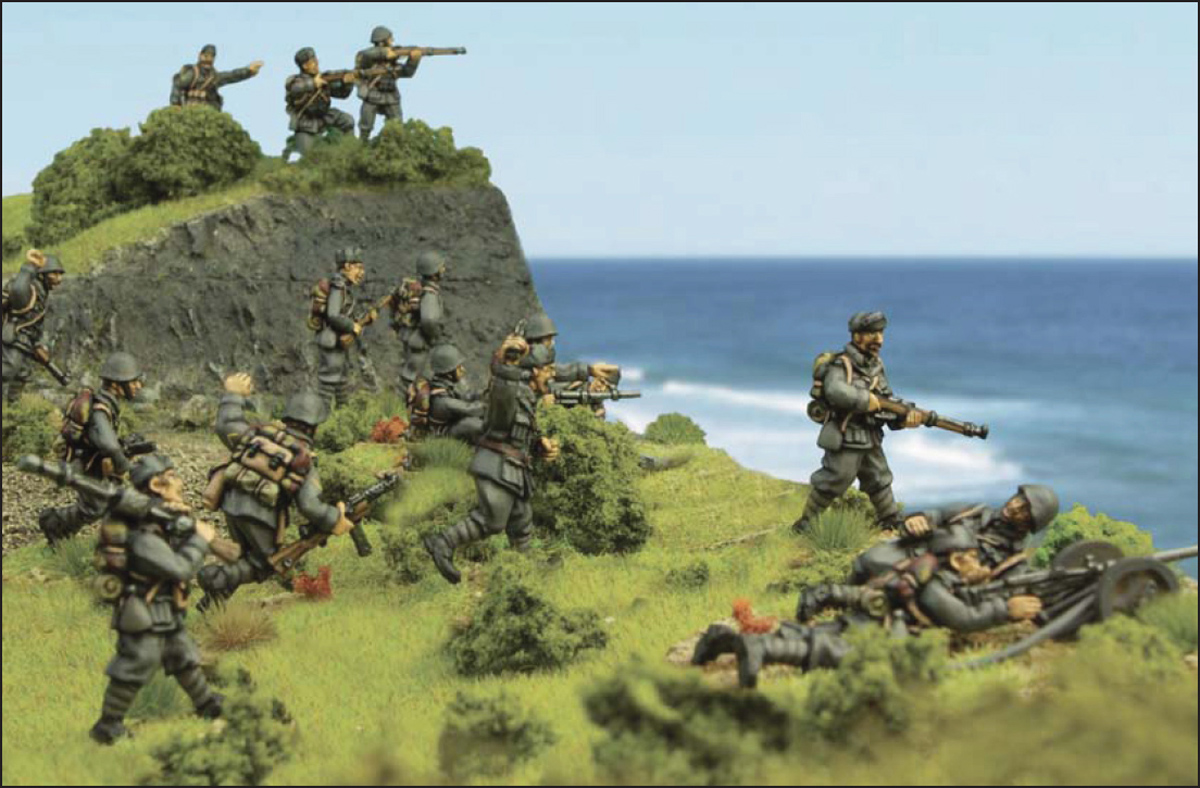
Italian soldiers rush to the cliffs and pour fire onto the American forces on the beaches below
The ‘Cannone 75/27’ designation can refer to the many different models of 75mm field guns and mountain guns used by the Italians, several of which were of World War I vintage. For example, the Modello 11 was a French pre-World War I design, notable for being the first artillery piece to use the now ubiquitous split trail system. Another notable example is the Cannone da 65/17 Modello 13 – a very lightly built mountain gun that was passed on to the normal infantry division for use as an infantry gun and stop-gap anti-tank gun. Even with outdated equipment, Italian artillerymen made a name for themselves, and tended to perform very well in the heat of battle!
Cost: 50pts (Regular), 60pts (Veteran)
Team: 3 men
Weapons: 1 light howitzer
Options:
• May add Spotter for +10pts
Special Rules:
• Gun shield
• Team weapon
• Fixed
• Howitzer
• HE (D6)
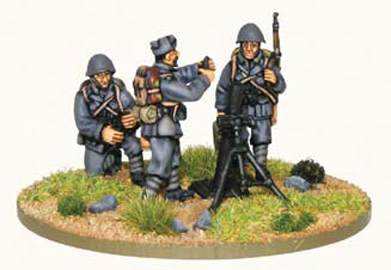
Italian Army medium mortar team
The 100/17 Modello 14 was a Skoda-designed medium howitzer that made up the bulk of the Italians’ artillery strength. As a whole, Italian artillery was a piecemeal collection from a previous era, although crewmen were well trained and made the most of the equipment they had. The bravery of the Italian artillerymen on the Eastern Front was legendary, often firing over open sights at the approaching enemy in an attempt to stem the Soviet tide. Another common type of medium gun was the Cannone da 105/32, converted from captured Austro-Hungarian 104 mm Feldkanone M15 field guns at the end of World War I.
Cost: 75pts (Regular), 90pts (Veteran)
Team: 4 men
Weapons: 1 medium howitzer
Options:
• May add Spotter for +10pts
Special Rules:
• Gun shield
• Team weapon
• Fixed
• Howitzer
• HE (2D6)
Italy did not have large amounts of heavy artillery pieces, and many were emplaced for coastal defence or kept on the Italian mainland for home defence, which means that many did not see action unless they were requisitioned by the German occupying troops after the armistice. Examples of these heavy guns, which much like the smaller calibres were mostly from World War I or even before, are the Cannone da 149/35 A, the Cannone da 149/40 and the Cannone da 152/45.
Cost: 115pts (Regular), 138pts (Veteran)
Team: 5 men
Weapon: 1 heavy howitzer
Options:
• May add Spotter for +10pts
Special Rules:
• Gun shield
• Team weapon
• Fixed
• Howitzer
• HE (3D6)
The 47/32 was a licensed Austrian light artillery piece that primarily served in an anti-tank role. When firing HEAT [High Explosive Anti-Tank] rounds, the 47/32 was an effective AT platform in the earlier stages of the war. With a low silhouette (made even lower by the removal of its wheels, a common practice) and relative high mobility, the Elefantino proved itself in battle time and again. The same weapon equipped the main gun of the Italian mainstay tank, the M14/41, and the 47/32 self-propelled gun.
Cost: 36pts (Inexperienced), 45pts (Regular), 54pts (Veteran)
Crew: 3 men
Weapon: 1 light anti-tank gun
Options:
• Add a gun shield for +5 pts, to represent the German-produced 37mm anti-tank gun (PaK 36) that was used by the Italian army as the ‘37/45 anti-tank gun’
Special Rules:
• Team weapon
• Fixed
• Gun shield, if option is taken
The 75/39 was a German-made 75mm anti-tank gun that was produced for the Wehrmacht with the name of PaK 97/38. The gun was a stop-gap measure soon to be replaced by the much more effective PaK 40, and many of them were given by the Germans to their allies, particularly on the Eastern Front.
Cost: 60pts (Inexperienced), 75pts (Regular), 90pts (Veteran)
Crew: 3 men
Weapon: 1 medium anti-tank gun
Special Rules:
• Team weapon
• Fixed
• Gun shield
Italian guns were named with two numbers, as in cannone 47/32 (47/32 cannon). The first number indicated the calibre, while the second was the length of the barrel, measured in multiples of the calibre. So, the aforementioned 47/32 was a 47mm calibre gun with a barrel 47x32mm long, which is 1,504mm (approximately 1.5 metres).
The Breda 20/65 Model 1935 was developed in Italy and widely used throughout the war. The weapon was diverse, capable as both an anti-aircraft weapon and a ground weapon. After Operation Compass ended in early 1941, the British captured large numbers of Breda 20mms and put them to use throughout their armed forces, including the famed LRDG (Long Range Desert Group). They provided the main armament on numerous Italian vehicles, including many of their Autosahariana trucks, AB41 armoured cars, and several others.
Cost: 40pts (Inexperienced), 50pts (Regular), 60pts (Veteran)
Team: 3 men
Weapon: 1 light automatic cannon
Special Rules:
• Team weapon
• Fixed
• Flak
A very reliable and powerful anti-aircraft gun, the 75/46’s high velocity shells made it a very good choice for anti-tank use. Many 75/46s were captured by the Germans after the armistice and put to use alongside the dreaded ‘88’.
Cost: 88pts (Inexperienced), 110pts (Regular), 132pts (Veteran)
Crew: 4 men
Weapon: 1 heavy anti-tank gun
Special Rules:
• Team weapon
• Fixed
• Flak
This 90mm calibre anti-aircraft gun was very similar to the German 8.8cm FlaK 36, and as with the German gun it also proved effective in the anti-tank role. Designed by Ansaldo in 1939, the guns were very well received, but Italian Industry could not meet the demand and very few were available. Some were mounted onto the Semovente 90/53. This entry can also be used for German 8.8cm FlaK 36 guns in use by the Italian army.
Cost: 112pts (Inexperienced), 140pts (Regular), 168pts (Veteran)
Crew: 5 men
Weapon: 1 super heavy anti-tank gun
Special Rules:
• Team weapon
• Fixed
• Flak
The name of Italian tanks normally consisted of a code made of a letter and two numbers (for example M14/41). The letter was either L for ‘leggero’ (light), M for ‘medio’ (medium), or P for ‘pesante’ (heavy). The first number was an approximate indication of the weight in tonnes and the second number was the year it came into active service. So an M14/41, to continue the example, was a Medium tank, weighing around 14 tons, which entered service in 1941. Other vehicles were often named after their main gun; for example the Semovente 47/32 was roughly the equivalent of ‘Self-propelled 47/32 gun’.
Based on the design of the Renault FT-17 tank, the FIAT 3000A (or L5/21) was first developed just after the end of World War I. It was soon upgraded to the 3000B model (or L5/30), which had a better engine and replaced the machine guns with a single 37mm gun. Despite being completely obsolete before the start of the war, it saw action in the Balkans and East Africa, as well as during the defence of mainland Italy. Principal service: 1921–43. Numbers manufactured: 152.
Cost: 40pts (Inexperienced), 50pts (Regular), 60pts (Veteran)
Weapons: Two turret-mounted MMGs
Damage Value: 7+ (tankette)
Options:
• May replace both MMGs with a light anti-tank gun for +30pts
Special Rules:
• 1-man turret. It is always necessary to make an order test when issuing an Advance order, even if the tank is not pinned
• Slow
Developed based on the British Carden Loyd tankette design, Italy’s L3 tankettes were the most numerous armoured fighting vehicles of the Italian war effort. At the war’s onset, the majority of Italy’s tank formations were equipped with L3s, and even early on the little L3 was outclassed by nearly every other armoured fighting vehicle it would square up against. The vehicle went through many modifications and adaptations over the years, and the L3/35 variant was notably upgraded to carry two 8mm machine guns instead of the single 6.5mm machine gun of the L3/33. Some L3s were refit to carry several different types of weapons, from a flamethrower to a heavy machine gun or a Solothurn anti-tank rifle. Principal service: 1933–43. Numbers manufactured: 2,000–2,500.
Cost: 48pts (Inexperienced), 60pts (Regular), 72pts (Veteran)
Weapons: 1 forward-facing hull-mounted MMG
Damage Value: 7+ (tankette)
Options:
• L3/35 variants – may replace the single MMG with one of the following (all forward-facing, hull-mounted): two MMGs for +10pts, an anti-tank rifle for +5pts, an HMG for +10pts, a flamethrower with co-axial MMG for +35pts
Special Rules:
• Slow, when upgraded with a flamethrower (as the extra fuel weighed the vehicle down considerably). Also remember that flamethrowing vehicles are more vulnerable to enemy fire; see p.51 of the rulebook
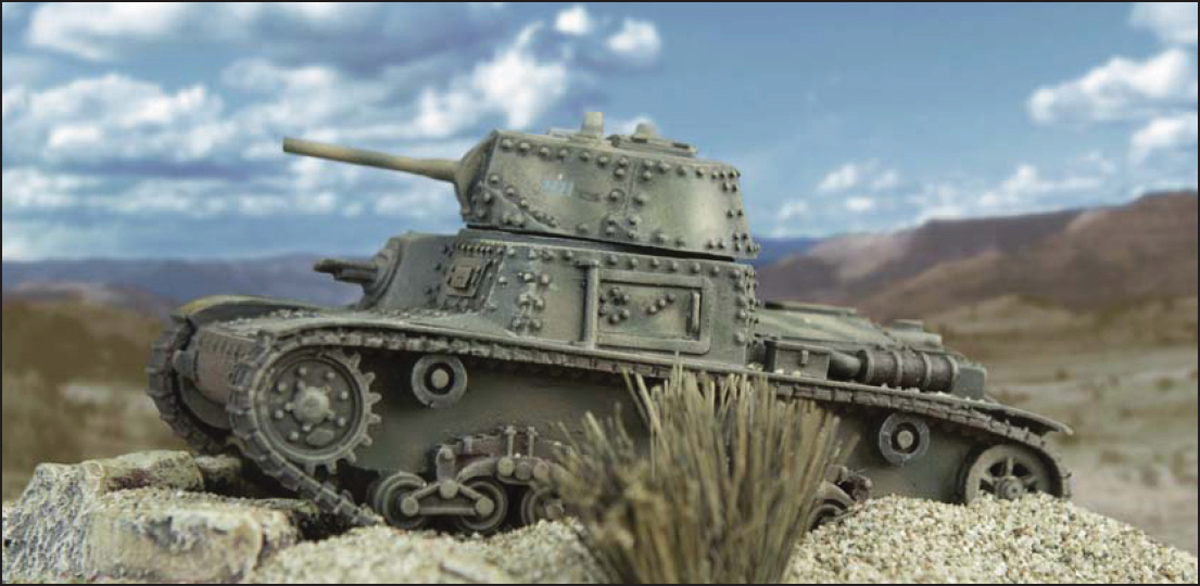
An M13/40 medium tank crests a ridge in the Italian foothills
Although envisioned as a breakthrough tank, the M11/39’s career was cut short with the introduction of the M13/40, which was built on the same chassis. The M11/39 sported a hull-mounted 37mm weapon designed to engage hard targets, and a turret-mounted, twin-machine gun designed to protect the tank from infantry assault. By the time the M11/39 saw any substantial combat against the British, the model made little impact, as the much heavier Matilda tanks simply struck them aside. Their use as static defences was ill-suited to the tank’s design. Principal service: 1939–43. Numbers manufactured: 96.
Cost: 104pts (Inexperienced), 130pts (Regular), 156pts (Veteran)
Weapons: 1 forward-facing hull-mounted light anti-tank gun and 2 turret-mounted MMGs
Damage Value: 8+ (light tank)
Options:
• Add an additional turret-mounted pintle-mounted MMG for +15pts
Special Rules:
• Vulnerable: because of the riveted construction, all shots to the side and rear of the vehicle get an additional +1 penetration modifier (i.e. in total, +2 for side hits and +3 for rear hits)
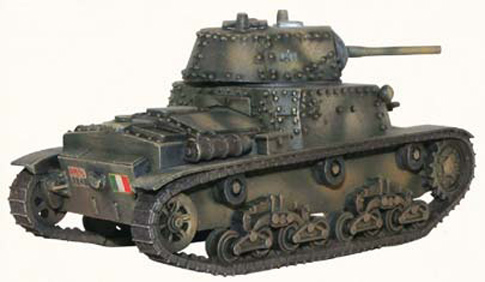
M13/40 medium tank
The FIAT M14/41 was an upgraded version of the M13/40, and together comprised the bulk of Italy’s combat effectiveness in its armoured divisions. The tank was comparable in terms of size and armour to many other light tanks of the early war period, and was easily capable of facing British light and cruiser tanks, though not the heavier infantry tanks. Its 47mm main gun was superior to the British 2-pdr, but easily outmatched with the introduction of heavier tank guns such as the 6-pdr and US 75mm. The 47mm calibre gun’s HE round did prove highly effective against infantry and towed guns, however. The Italian armoured divisions were the closest units the Italians had to a modernized force, and earned several resounding successes in the earlier stages of the war in North Africa. Principal service: 1940–43. Numbers manufactured: 779 (M13/40), 800 (M14/41).
Cost: 108pts (Inexperienced), 135pts (Regular), 162pts (Veteran)
Weapons: 1 turret-mounted light anti-tank gun with co-axial MMG and 2 hull-mounted MMGs
Damage Value: 8+ (light tank)
Options:
• Add an additional turret-mounted pintle-mounted MMG for +15pts
• Downgrade the tank to an M13/40 for -10pts, making the tank Slow
Special Rules:
• Vulnerable: because of the riveted construction, all shots to the side and rear of the vehicle get an additional +1 penetration modifier (i.e. in total, +2 for side hits and +3 for rear hits)
• Slow (if downgraded to an M13/40)
The FIAT M15/42 was the last of the ‘medium tanks’ produced by FIAT before the Italian surrender. Very few were made and they saw action only against the German occupying troops before being requisitioned by the Germans for use in the defence of northern Italy. They were equipped with an improved version of the 47mm anti-tank gun together with two co-axial machine guns in the turret and a further two in the hull. Principal service: 1942–45. Numbers manufactured: 118.
Cost: 116pts (Inexperienced), 145pts (Regular), 174pts (Veteran)
Weapons: 1 turret-mounted light anti-tank gun with 2 co-axial MMGs and 2 hull-mounted MMGs
Damage Value: 8+ (light tank)
Options:
• Add an additional turret-mounted pintle-mounted MMG for +15pts
The Renault R35 was a light two-man tank designed in the 1930s and built from 1936 onwards. It was the most numerous modern tank in the French army, with over 1500 made. Around 100 were captured by the Italians after the French surrender and used throughout the war.
Cost: 96pts (Inexperienced), 120pts (Regular), 144pts (Veteran)
Weapons: 1 turret-mounted low-velocity light anti-tank gun and 1 forward-facing hull MMG
Damage Value: 8+ (light tank)
Options:
• Upgrade the low-velocity light anti-tank gun to a light anti-tank gun (SA 38) to represent R40 or uprated R35 – +10pts
Special Rules:
• 1-man turret: combining the roles of commander, gunner and loader in together and squeezing the man responsible into a tiny 1-man turret means it is hard to do different things at once! To represent this it is always necessary to make an order test when issuing an Advance order, even if the tank is not pinned
• Armoured all round: the R35 was almost as heavily armoured at the sides and rear as at the front, so no modifiers apply for penetration when shooting at the sides, rear or from above. All shots count the full armour value
• Low velocity light anti-tank gun: the R35’s puny weapon counts as a light anti-tank gun but with an armour penetration rating of +3 instead of the usual +4
• Slow
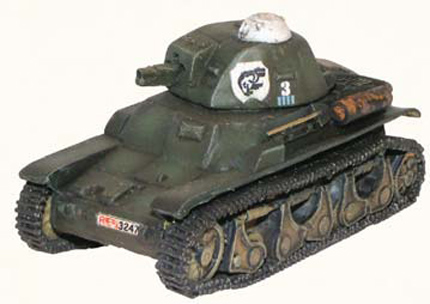
Italian R35 light tank
In an attempt to mobilize the Italian artillery on the North African front, some of the very heavy Lancia 3Ro trucks were converted to carry Skoda 100/17 howitzers and saw action against the Eighth Army. Principal service: 1941–42. Numbers manufactured: around 20.
Cost: 68pts (Inexperienced), 85pts (Regular), 102 (Veteran)
Weapons: 1 forward-facing or rear-facing medium howitzer
Damage Value: 6+ (soft skin)
Options:
• Add an additional forward-facing pintle-mounted MMG for +15pts
Built on the chassis developed for the L6/40, the Semovente 47/32 was an easy-to-produce tank hunter built as a stopgap measure to combat enemy armour. Mounting the excellent Elefentino anti-tank gun in an open-topped chassis gave the Italian forces some much-needed mobility in their anti-tank assets. The tank hunter initially fared well in the western desert, but lack of an armoured crew compartment became a glaring drawback in the system’s design. The Semovente 47/32 served from 1942 all the way through to 1945, finding use in the German army after the Italian capitulation. Principal service: 1942–43. Numbers manufactured: around 300.
Cost: 68pts (Inexperienced), 85pts (Regular), 102pts (Veteran)
Weapons: 1 forward-facing hull-mounted light anti-tank gun
Damage Value: 7+ (tankette)
Options:
• May have a forward-facing pintle-mounted MMG for +15pts
• May be upgraded to Command tank for –15pts, replacing the antitank gun with a MMG
Special Rules:
• Vulnerable: because of the riveted construction, all shots to the side and rear of the vehicle get an additional +1 penetration modifier (i.e. in total, +2 for side hits and +3 for rear hits)
• Open-topped
• Command vehicle, if option is taken
After witnessing the success of the German StuG in Europe, the Italians decided a tank of comparable design was needed. By 1942, the Semovente 75/18 was fighting for the Italians in North Africa, where it would distinguish itself as one of the nation’s best tank designs. The 75/18 had a relatively modern gun, thicker front armour than any of the M-series tanks, and it proved quite successful in service, capable of destroying all but the heaviest Allied armoured vehicles. The Semovente 75/18 was present in nearly every major engagement the Italians took part in, and continued service as a captured tank in the German army after the fall of the Regio Esercito. Principal service: 1942–43. Numbers manufactured: 765.
Cost: 136pts (Inexperienced), 170pts (Regular), 204pts (Veteran)
Weapons: 1 forward-facing hull-mounted medium anti-tank gun
Damage Value: 9+ (medium tank)
Options:
• Add an additional forward-facing pintle-mounted MMG for +15pts
Special Rules:
• Vulnerable: because of the riveted construction, all shots to the side and rear of the vehicle get an additional +1 penetration modifier (i.e. in total, +2 for side hits and +3 for rear hits)
• HE: Instead of causing D2 HE hits, an HE shell causes D6 hits (75mm gun tanks)
Arguably the best armoured vehicle produced by Italy during the war, the Semovente 105/25 ‘Bassotto’ (dachshund) was armed with a formidable 105mm anti-tank gun mounted on the chassis of a Fiat M15/42 tank. Its low profile and powerful weapon made it an excellent tank destroyer, but only 30 were produced before the Italian surrender. The Germans occupied the factories and continued its production for their own use. Principal service: 1943–45. Numbers manufactured: 30 (for the Italian army) and then 60 (for the German army).
Cost: 240pts (Inexperienced), 300pts (Regular)
Weapons: 1 forward-facing hull-mounted super heavy anti-tank gun
Damage Value: 9+ (medium tank)
Options:
• Add an additional forward-facing pintle-mounted MMG for +15pts
Only seeing combat in the latter stages of the Italian involvement in the war, the Semovente 90/53 was a monster to behold. Initially designed to combat the heavier Soviet tanks on the Eastern Front, the Semovente 90/53 mounted the powerful 90mm anti-tank gun, which was comparable to the German ‘88’ in destructive power. Though the tank hunter never actually saw service on the Eastern Front, it surprised the Allies in Sicily in 1943. Suffering from the same drawbacks as many other light tank hunters (namely, lack of an armoured crew compartment), the few Semovente 90s developed were adopted by the German army after the fall of Italy. Principal service: 1942–43. Numbers manufactured: 30.
Cost: 180pts (Inexperienced), 225pts (Regular)
Weapons: 1 forward-facing hull-mounted super heavy anti-tank gun
Damage Value: 7+ (tankette)
Special Rules:
• Vulnerable: because of the riveted construction, all shots to the side and rear of the vehicle get an additional +1 penetration modifier (i.e. in total, +2 for side hits and +3 for rear hits)
• Open-topped
Several trucks were converted to carry anti-aircraft weapons mounted on rotating platforms. These weapons ranged from the light Breda 20mm to the powerful 90mm anti-aircraft gun, which was often used in an anti-tank role. This heavy gun was mounted on the suitably large autocarro pesante unificato Lancia 3Ro, but even so, it required the truck to be supported by stabilizer jacks before firing. Principal service: 1938–43. Numbers manufactured: around 120 with the 90mm, unknown with the 20mm.
Cost: 40pts (Inexperienced), 50pts (Regular), 60 (Veteran)
Weapons: 1 light automatic cannon with 360º arc of fire
Damage Value: 6+ (soft skin)
Options:
• Replace the light automatic cannon with a super heavy anti-tank gun and stabilizer jacks for +150pts
Special Rules:
• Flak
• Stabilizer jacks (if option is taken). The vehicle may not fire if given an Advance order
Italy’s AB41 was the most-produced armoured car of the Italian armed forces. Production began in 1940, and the Autoblinda 41 served in several theatres, most notably in Africa, given its environmental adaptability – crews could quickly change wheel configurations to fit many surfaces, even rails. Like some German armoured cars of the day, the AB41 also featured two driving positions, allowing the vehicle to travel effectively in either direction. A previous machine-gun armed model, the AB40, was manufactured in small numbers before production was switched to the AB41. Principal service: 1941–43. Numbers manufactured: 550.
Cost: 84pts (Inexperienced), 105pts (Regular), 126pts (Veteran)
Weapons: 1 turret-mounted light automatic cannon with co-axial MMG and 1 rear facing hull-mounted MMG
Damage Value: 7+ (armoured car)
Options:
• Add a turret-mounted pintle-mounted MMG for +15pts
• Replace the turret-mounted automatic cannon and co-axial MMG with 2 MMGs for –15pts (representing the older AB40 model)
Special Rules:
• Recce (dual direction steering)
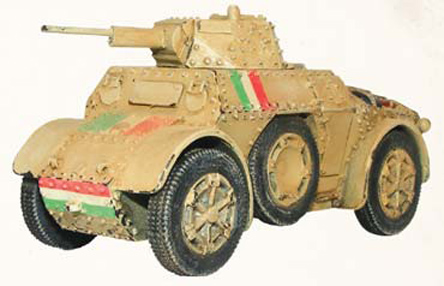
Autoblinda AB41
More properly named the ‘SPA-Viberti AS-42 Camionetta Sahariana’, this scout car (and the later AS-43 version) was based on the same chassis as the AB41 armoured car, including the dual direction steering. With its great flexibility, excellent performance and multiple weapon options, the Sahariana was regarded by both sides as the best vehicle in its role. Not many were manufactured, however, because it was extremely expensive to produce and maintain. Initially deployed to counter the activity of the British LRDG and SAS, after the end of the war in Africa more units of Saharianas were used in mainland Italy. Principal service: 1942–43. Numbers manufactured: around 100.
Cost: 30pts (Veteran)
Weapons: See below
Damage Value: 6+ (soft skin)
Options:
• Add a forward-facing pintle-mounted MMG for +15pts
• Add a rear-facing pintle-mounted MMG for +15pts
• Add one of the following weapons with a 360º arc of fire: a pintle-mounted MMG for 15pts, an anti-tank rifle for +15pts, a light automatic cannon for +35pts or a light anti-tank gun for +50pts
Special Rules:
• Recce (dual direction steering)
• Flak (only for the pintle-mounted MMGs and for the light automatic cannon)
Lightly armed and armoured, the Lince (Lynx) served as a reconnaissance vehicle for the Italian forces of World War II. A nearly identical copy of the British Dingo, the Lince was armed with a ball-mounted 8mm Breda M38 machine gun, but was protected by roughly half the armour of the Dingo at its thickest point. This is represented by the open-topped rule, even if the vehicle had armoured hatches to enclose the crew compartment. Principal service: 1943. Numbers manufactured: 250.
Cost: 52pts (Inexperienced), 65pts (Regular), 78pts (Veteran)
Weapons: 1 forward-facing MMG
Damage Value: 7+ (armoured car)
Special Rules:
• Recce
• Open-topped
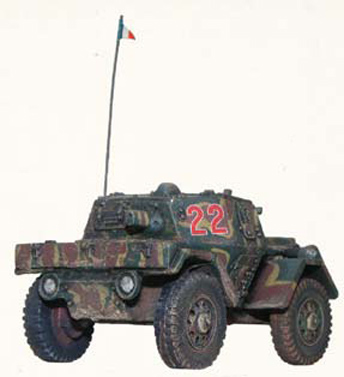
Autoblinda Lince
The FIAT L6/40 was the final light tank design in widespread use by the Italian army. By the time the first L6/40 rolled off the assembly line, it was already obsolete and so was used as a battle tank only in the most desperate circumstances. The tank’s small size and low silhouette, however, made it ideal for reconnaissance duty. It saw service in Africa, Sicily, Italy, and the Eastern Front. Armed with a 20mm Breda, the L6/40 could lay down an impressive rate of fire, but lacked the punch seriously to threaten enemy armour. Principal service: 1940–44. Numbers manufactured: 283.
Cost: 76pts (Inexperienced), 95pts (Regular), 114pts (Veteran)
Weapons: 1 turret-mounted light automatic cannon with co-axial MMG
Damage Value: 8+ (light tank)
Options:
• May replace the automatic cannon with a flamethrower for +10pts
• Alternatively, it may be upgraded to Command tank for +20pts
Special Rules:
• Recce
• Vulnerable: because of the riveted construction, all shots to the side and rear of the vehicle get an additional +1 penetration modifier (i.e. in total, +2 for side hits and +3 for rear hits)
• 1-man turret: it is always necessary to make an order test when issuing an Advance order, even if the tank is not pinned
• If flamethrower option is taken, the vehicle loses the Recce rule. Also remember that flame-throwing vehicles are more vulnerable to enemy fire; see p.51 of the rulebook
• Command vehicle and Open-topped if the Command tank option is taken
The FIAT 508 CM was the military version of the civilian 508 C, also known as the FIAT 1,100. Rugged and reliable, it was used extensively by the Reggio Esercito in multiple roles, from staff car to off-road recon vehicle. Principal service: 1938–43. Numbers manufactured: 6,000.
Cost: 18pts (Inexperienced), 23pts (Regular), 28pts (Veteran)
Weapons: None
Damage Value: 6+ (soft skin)
Transport: 4 men
Italy used a variety of trucks during the war, mostly produced by FIAT-SPA and Lancia. One of the most numerous trucks was the Dovunque 35, a well-designed vehicle fitting the needs of the Reggio Esercito. Its cab-over-motor design and overall vehicle dimensions meant that it was quite capable off-road and in mountainous conditions. Principal service: 1940–43. Numbers manufactured: unknown, but in the order of tens of thousands.
Cost: 31pts (Inexperienced), 39pts (Regular), 47pts (Veteran)
Weapons: None
Damage Value: 6+ (soft skin)
Transport: 12 men
Tow: Light howitzer; light or medium anti-tank gun, light anti-tank gun
Options:
• Add a forward-facing pintle-mounted MMG for +15pts
The FIAT-SPA Autocarro Protetto S37 was an Italian-made armoured troop carrier. In contrast to the more common designs of German and Allied equivalent vehicles, it was not a half-track, but relied instead on a robust four-wheel drive and very large tyres for cross-country movement. Principal service: 1941–43. Numbers manufactured: 200.
Cost: 49pts (Inexperienced), 61pts (Regular), 73pts (Veteran)
Weapons: None
Damage Value: 7+ (armoured carrier)
Transport: 8 men
Tow: Light howitzer; light or medium anti-tank gun, light anti-aircraft gun
Options:
• Add a forward-facing or rear-facing pintle-mounted MMG for +15pts
Special Rules:
• Open-topped
Like many nations involved in the war, Italy needed an effective method of transporting its artillery to where it was needed, and the FIAT-SPA’s TM-series of tractors were the answer. They used four-wheel steering and drive to help them negotiate both the sandy conditions of North Africa and the mountainous terrain found in parts of Italy. Principal service: 1940–43. Numbers manufactured: 250.
Cost: 12pts (Inexperienced), 15pts (Regular), 18pts (Veteran)
Weapons: None
Damage Value: 6+ (soft skin)
Tow: Any howitzer; any anti-tank gun, any anti-aircraft gun
The Breda 61 was a German SdKfz 7 half-tracked artillery tractor manufactured in Italy under licence. The main difference between the Breda 61 and it’s German counterpart was the Italian version had right-hand drive. Principal service: 1943. Numbers manufactured: 250.
Cost: 40pts (Inexperienced), 50pts (Regular), 60pts (Veteran)
Weapons: None
Damage Value: 7+ (armoured carrier)
Tow: Any howitzer; any anti-tank gun, any anti-aircraft gun
Special Rules:
• Open-topped
After Italy’s capitulation on 3 September 1943, the Wehrmacht invaded the territory of their former ally and took control of all military assets. This meant that a number of new vehicles that were in the early stages of production, as well as the factories manufacturing them, were seized by the Germans and put to use against the Allies who were working their way up the Italian peninsula. Some such vehicles represented much-improved versions of existing designs, but we have not included them in this book as they were never part of the Reggio Esercito. Examples of these are the Semovente 105/25, the P26/40 heavy tank, and the AB43 armoured car.
The following theatre selectors cover the main four sectors where Italian forces were engaged during World War II: the Balkans (Greece, Yugoslavia and their island possessions in the Mediterranean), Africa (North and East Africa), the Eastern Front and finally the defence of Italy. There were other minor engagements that saw Italian forces in action, like the attack on southern France before the French capitulation, but we have chosen not to go into that much detail in this book.
Before playing a game, the players must decide the theatre selector from which they wish to pick their reinforced platoon. If they wish, opponents can ‘match up’ their armies so that they are contemporary with each other. To give two examples, an Italian army from the war in Africa list would be well matched against a British force from any of the British lists set in Africa, whilst an Italian army from the Eastern Front list could take on a Soviet force from the Operation Uranus list.
Obviously, there is nothing to stop players fighting battles between forces from different periods and theatres. Whilst not historically accurate, players often like to try ‘what if’ type games. In reality, an Italian army from 1940 will have very little chance of beating a late war army of any nation, such was the rapid development of weapons and equipment. The points values will ensure that such a game of Bolt Action is fairly evenly balanced, but don’t be surprised if you have trouble penetrating the armour of late-war super heavy tanks with an Elefantino.
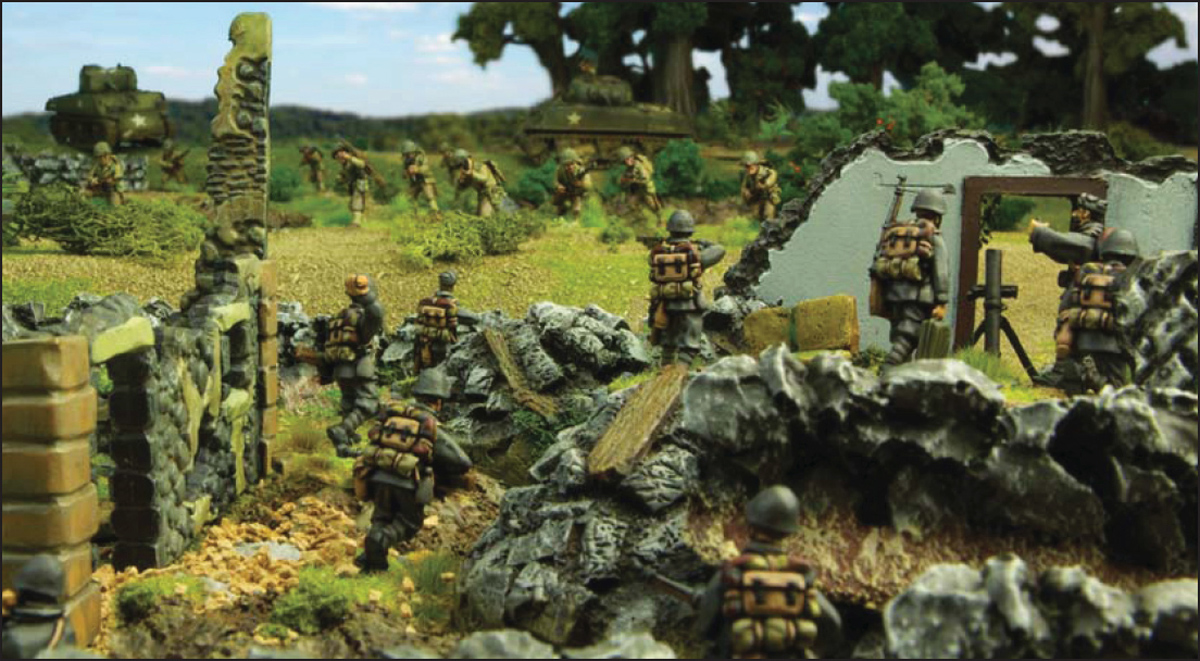
Il Duce’s army prepares to defend their homeland
After occupying Albania, the Italians launched their poorly planned assault on Greece, kicking off vicious fighting in the Balkans. Mussolini, eager to match the successes of Hitler in Europe, ordered his ill-prepared troops into the mountainous terrain of northern Greece in late October of 1940. The Greeks resisted valiantly and pushed the poorly equipped Italians back into Albania, and thus forced the Germans to intervene and invade Greece through Yugoslavia. Greece surrendered in April 1941. Italian forces occupied Greece and Yugoslavia, where they were engaged in anti-partisan operations until the end of the war.
An Italian force for the Invasion of Greece must comprise one or more Reinforced Platoons picked from the following theatre selector. Each Reinforced Platoon is made up as follows:
1 Lieutenant – First or Second (Inexperienced or Regular)
2 Inexperienced infantry sections (at least one section must be Green)
plus:
Headquarters
0–1 Captain or Major
0–1 Medic
0–1 Forward Observer
Infantry
0–4 Infantry sections: Regular infantry sections, Inexperienced infantry sections, Bersaglieri infantry sections, Camicie Nere militia infantry section, Alpini infantry section
0–1 Machine gun team
0–1 Sniper team
0–1 Anti-tank rifle team
0–1 Flamethrower team
0–1 Mortar team: light mortar team, medium mortar team
Artillery
0–1 gun from:
Anti-tank gun: 47/32 Elefantino
Field artillery: light artillery, medium artillery, heavy artillery
Anti-aircraft gun: Breda 20mm AA gun, 75/36 heavy AA gun
Armoured Cars and Recce Vehicles
0–1 vehicle from: L6/40 light tank, Autoblinda 41
Tanks, Self-Propelled Guns and Anti-Aircraft Vehicles
0–1 vehicle from: FIAT 3000, L3 Tankette (any variant), M11/39, M13/40 (no M14/41), AA trucks
Transports and Tows
0–1 transport vehicle per infantry unit in the Reinforced Platoon from: FIAT 508 CM, truck
0–1 tow from: wheeled artillery tractor
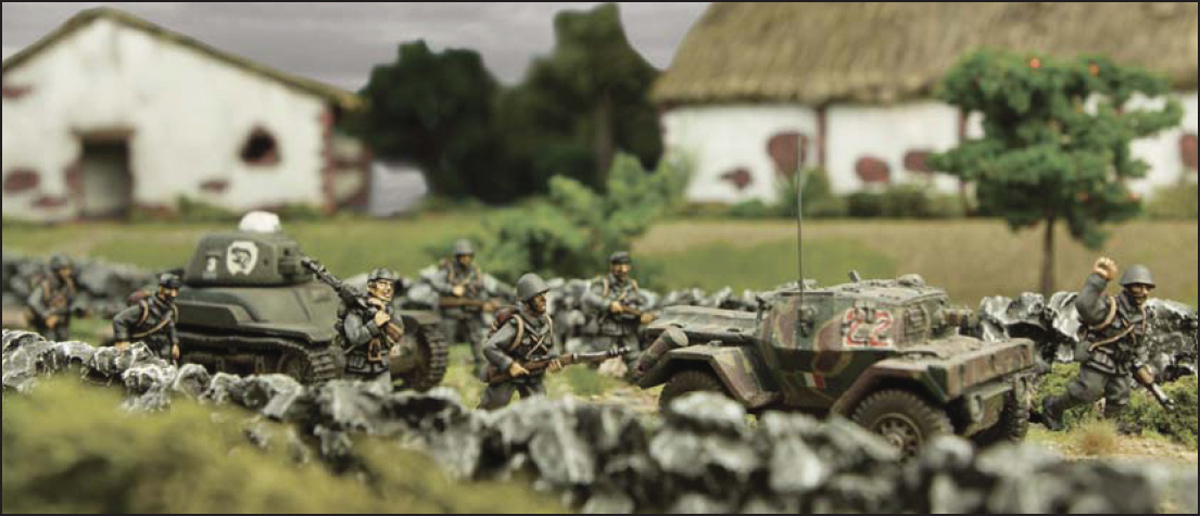
Italian reinforcements head to the front
Once war was declared against the United Kingdom and its Allies, Italy was quick to attack Allied colonial holdings in East and North Africa. Italy’s armies in Africa generally made small gains initially before halting their attacks to fortify their new positions. Pushed back by stubborn British resistance and counter-attacks, starved of supplies by the Royal Navy, the Italian armies were quickly defeated in East Africa, while in North Africa the battles continued as Rommel’s Afrika Korps joined the fray. Eventually, trapped in Tunisia between Montgomery’s relentless Eighth Army and the Allied forces that landed in French North Africa, the German and Italian forces in Africa surrendered to the Allies on May 1943. The Bersaglieri, Paracadutisti, and regular forces of Italy never succeeded in accomplishing the African domination Il Duce envisioned.
An Italian force for the war in Africa must comprise one or more Reinforced Platoons picked from the following theatre selector. Each Reinforced Platoon is made up as follows:
1 Lieutenant – First or Second
2 Infantry sections: Regular infantry sections, Inexperienced infantry Sections, Bersaglieri infantry sections, Paracadutisti infantry sections
plus:
Headquarters
0–1 Captain or Major
0–1 Medic
0–1 Forward Observer
Infantry
0–4 Infantry sections: Regular infantry sections, Inexperienced infantry sections, Bersaglieri infantry sections, Paracuditisti infantry sections, Camicie Nere militia infantry sections, San Marco marines infantry sections, Colonial troops infantry sections
0–1 Machine gun team
0–1 Sniper team
0–1 Anti-tank rifle team
0–1 Flamethrower team
0–1 Mortar team: light mortar team, medium mortar team
Artillery
0–1 gun from:
Anti-tank gun: 47/32 Elefantino
Field artillery: light artillery, medium artillery, heavy artillery
Anti-aircraft gun: Breda 20mm AA gun, 75/36 heavy AA gun, 90/53 heavy AA gun
Armoured Cars and Recce Vehicles
0–1 vehicle from: L6/40 light tank, Autoblinda 41, Sahariana
Tanks, Self-Propelled Guns and Anti-Aircraft Vehicles
0–1 vehicle from: FIAT 3000, L3 tankette (any variant), M11/39, M13/40, M14/41, 100/17 on Lancia Ro, Semovente 47/32, Semovente 75/18, AA trucks
Transports and Tows
0–1 transport vehicle per infantry unit in the Reinforced Platoon from: FIAT 508 CM, truck, Autoprotetto S37
0–1 tow from: wheeled artillery tractor
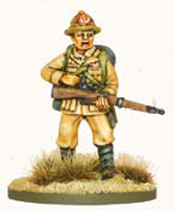

Italian infantry advance past an abandoned Australian ambulance
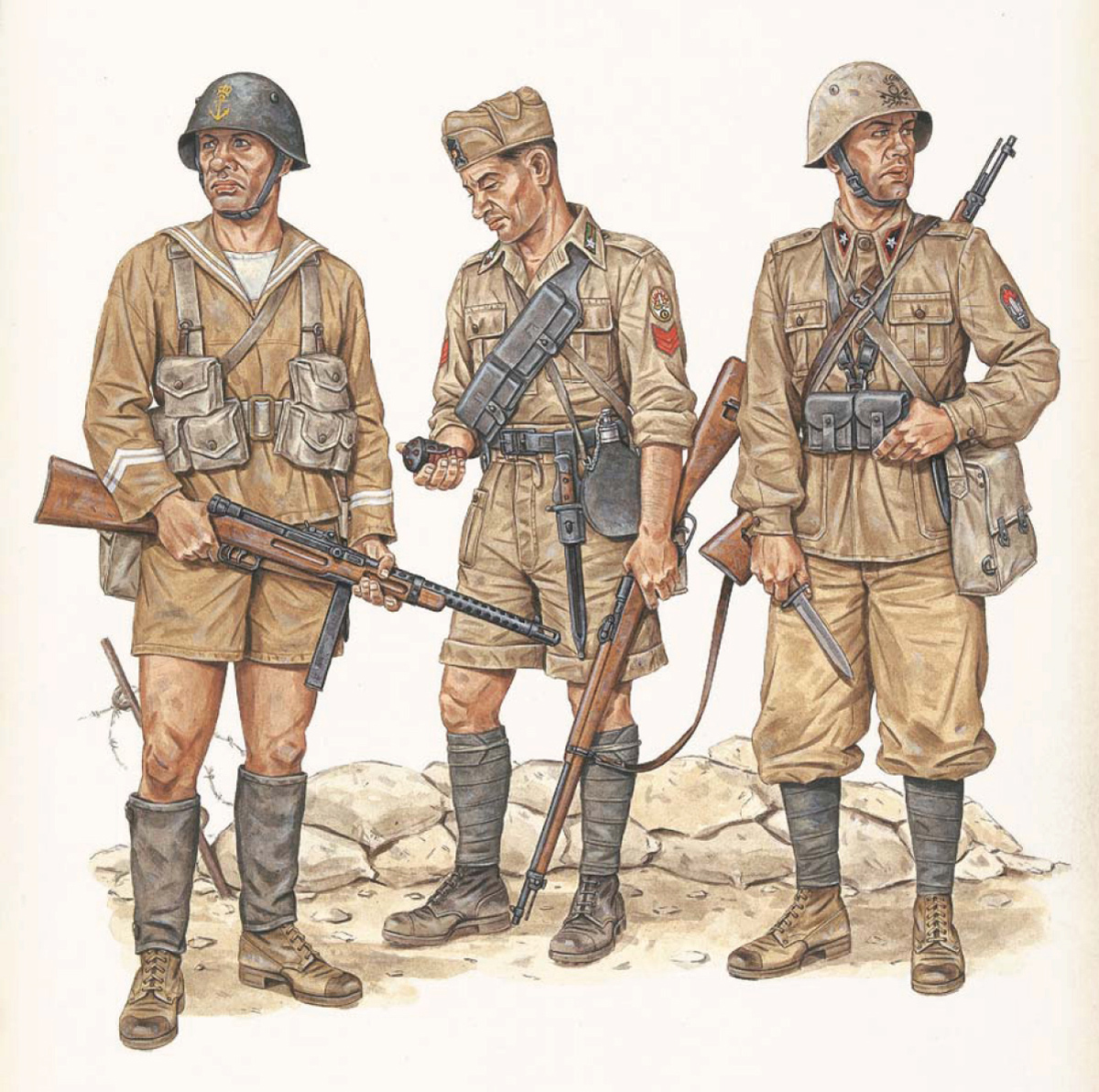
Italian troops in North Africa, 1942 (L–R): Marine, ‘San Marco’ Marine Bn; Caporale maggiore, 27th Inf Regt, ‘Pavia’ Inf Div; Soldato, 31st Guastatori Bn, by Stephen Andrew © Osprey Publishing Ltd. Taken from Men-at-Arms 349: The Italian Army 1940–45 (2).
The Italian Eighth Army served as Mussolini’s contribution to the Axis efforts on the Eastern Front. Elements of the Eighth Army pursued fleeing Soviet forces in the south, fended off Soviet attacks while vastly outnumbered on the Don River, and fought bravely and skilfully in many of the brutal engagements that characterized the fighting in the theatre. The long retreat through the Russian winter cost the Eighth Army 30,000 dead and 64,000 taken prisoner, of which a ghastly 54,000 died in Soviet captivity.
An Italian force for the Eastern Front must comprise one or more Reinforced Platoons picked from the following theatre selector. Each Reinforced Platoon is made up as follows:
1 Lieutenant – First or Second
2 Infantry Sections: Inexperienced infantry sections, Regular infantry sections, Alpini infantry sections
plus:
Headquarters
0–1 Captain or Major
0–1 Medic
0–1 Forward Observer
Infantry
0–4 Infantry sections: Regular infantry sections, Inexperienced infantry sections, Bersaglieri infantry sections, Camicie Nere militia infantry sections, Alpini infantry sections, Cavalry sections
0–1 Machine gun team
0–1 Sniper team
0–1 Anti-tank rifle team
0–1 Flamethrower team
0–1 Mortar team: light mortar team, medium mortar team
Artillery
0–1 gun from:
Anti-tank gun: 47/32 Elefantino, 75/39 anti-tank gun
Field artillery: light artillery, medium artillery, heavy artillery
Anti-aircraft gun: Breda 20mm AA gun, 75/36 heavy AA gun, 90/53 heavy AA gun
Armoured Cars and Recce Vehicles
0–1 vehicle from: L6/40 light tank
Tanks, Self-Propelled Guns and Anti-Aircraft Vehicles
0–1 vehicle from: L3 tankette (any variant), Semovente 47/32, AA trucks
0–1 vehicle from: Semovente 47
Transports and Tows
0–1 transport vehicle per infantry unit in the Reinforced Platoon from: FIAT 508 CM, truck
0–1 tow from: wheeled artillery tractor
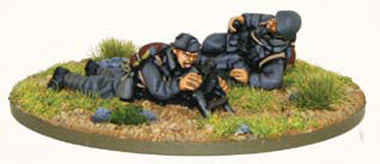
Italian Army Brixia light mortar team
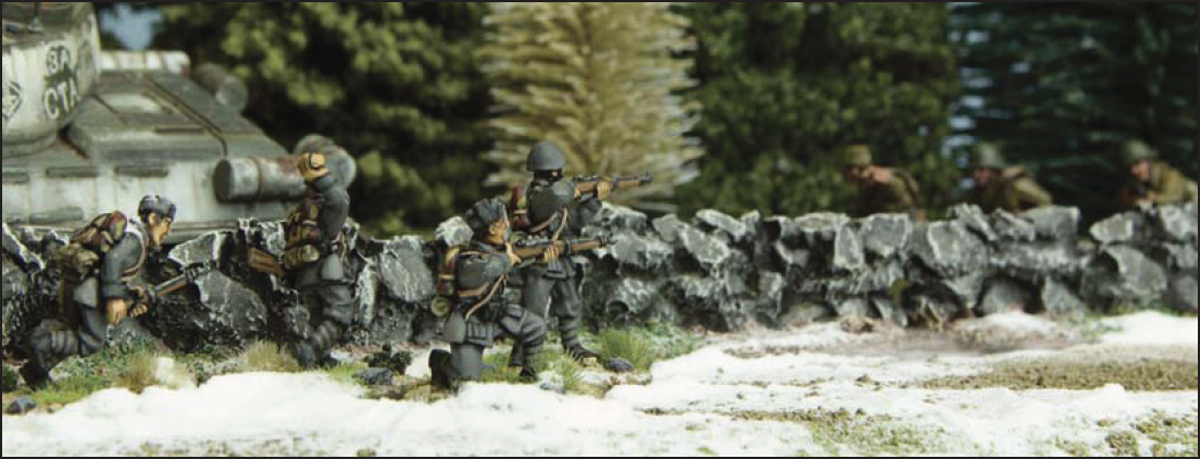
Italian and Soviet patrols clash on the Eastern Front

Italian troops on the Russian Front, 1942 (L–R): Volunteer, Italian Croatian Legion; Sergente, 79th Inf Regt, ‘Pasubio’ Inf Div; Alpino, ‘Monte Cervino’ Ski Bn, by Stephen Andrew © Osprey Publishing Ltd. Taken from Men-at-Arms 340: The Italian Army 1940–45 (1).
On 10 July 1943, Operation Husky brought Allied troops to Sicily to face its Italian and German defenders. The Italian Sixth Army found some success at first, capturing Allied paratroopers, but could not stop the subsequent beach landings. The Italians and Germans managed to delay the Allies, but could not ultimately halt the attack and withdrew to the Italian mainland. At the beginning of September 1943, as the Allies began landing in the south of Italy, the armistice was signed and the kingdom of Italy surrendered to the Allies, leading to the German invasion and the bitter civil war that followed.
An Italian force for the defence of Sicily must comprise one or more Reinforced Platoons picked from the following theatre selector. Each Reinforced Platoon is made up as follows:
1 Lieutenant – First or Second
2 Infantry Sections: Inexperienced infantry section, Regular infantry sections, Bersaglieri infantry sections
plus:
Headquarters
0–1 Captain or Major
0–1 Medic
0–1 Forward Observer
Infantry
0–4 Infantry sections: Regular infantry sections, Inexperienced infantry sections, Camicie Nere militia infantry section, Bersaglieri infantry sections
0–1 Machine gun team
0–1 Sniper team
0–1 Anti-tank rifle team
0–1 Flamethrower team
0–1 Mortar team: light mortar team, medium mortar team
Artillery
0–1 gun from:
Anti-tank Gun: 47/32 Elefantino, 75/39 anti-tank gun
Field artillery: light artillery, medium artillery, heavy artillery
Anti-aircraft gun: Breda 20mm AA gun, 75/36 heavy AA gun, 90/53 heavy AA gun
Armoured Cars/Recce Vehicles
0–1 vehicle from: L6/40 light tank, Autoblinda 41, Autoblinda Lince
Tanks, Self-Propelled Guns and Anti-Aircraft Vehicles
0–1 vehicle from: FIAT 3000, L3 tankette (any variant), M11/39, M13/40, M14/41, M15/42, Captured Renault R35, Semovente 47/32, Semovente 75/18, Semovente 105/25, Semovente 90/53, AA trucks
Transports and Tows
0–1 transport vehicle per infantry unit in the Reinforced Platoon from: FIAT 508 CM, truck, Autoprotetto S37
0–1 tow from: wheeled artillery tractor, Breda 61 artillery tractor